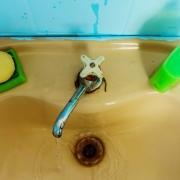Cleaning Rust from a Porcelain Sink Drain
Since water can accumulate in a sink, mold can accumulate in a drain flange and surrounding porcelain. The solution is doable. The strategy for porcelain is to find a substance that is harder than rust and softer than porcelain. Pumice stones are great to use on porcelain. As for metal, the acidic ingredient in the glue that gives it a sharp, spicy taste – phosphoric acid – can degrade the oxide in the metal much faster than the metal itself.
Instructions
- Get some phosphoric acid at a home improvement store. Finding a solution at 85 percent is ideal. The highest concentrations can be diluted with distilled water. You can also use naval jelly, which has phosphoric acid. Cola could also work, if left overnight.
- Close the drain by using the stopper.
- Use gloves and dip a piece of paper towel that will cover the rust stain on the drain metal.
- Moisten the paper towel with the phosphoric solution. Leave on for a few minutes. Next, pour a solution of baking soda and water on the paper towel to neutralize it. Because you are adding a water base to the acid instead of acid to the water, you will get a lively reaction.
- Raise the stopper and empty the sink. Brush the metal with a non-metallic brush to get rid of any film left behind.
- Wet a pumice stone, which can be obtained from the beauty section of most pharmacies.
- Scrape against any porcelain that has rust on it. Use small strokes directly on the rust, much like a pencil eraser. The rust will come right off the porcelain.






